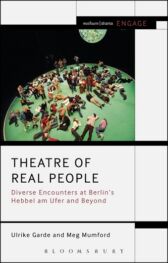Synopsis
Theatre of Real People
Published by Methuen
After providing a history of this mode of performance, and theoretical frameworks for its analysis, the book focuses on work developed by seminal practitioners at Berlin's Hebbel am Ufer (HAU) production house
It invites the reader to explore the HAU's innovative approach to Theatre of Real People, authenticity and cultural diversity during the period of Matthias Lilienthal's leadership (200312).
Garde and Mumford also elucidate how Theatre of Real People can create and destabilise a sense of the authentic, and suggest how Authenticity-Effects can present new ways of perceiving diverse and unfamiliar people
Through a detailed analysis of key HAU productions such as Lilienthal's brainchild X-Apartments, Mobile Academy's Blackmarket, and Rimini Protokoll's 100% City, the book explores both the artistic agenda of an important European theatre institution, and a crucial aspect of contemporary theatre's social engagement
TABLE OF CONTENTS
Introduction
1. A Historical Perspective on Theatre of Real People
2. Theatre of Real People at the HAU
3. Theatre and Authenticity-Effects
4. Encounters with Cultural Diversity at the HAU
5. Berliners with an 'Authenticity Guarantee': Cultural Complexity in 100% Berlin and 100% City
6. Meeting Unfamiliar Residents in Berlin: Playing with Frames of Reference in X-Apartments
7. Unsettling Journey into the Unfamiliar: Ambiguous Guides to the City in Call Cutta: Mobile Phone Theatre
8. Getting Closer to the Subject(s) of Migration: Partial Proximity in Schwarzmarkt No. 7 and Mr Dagaçar and the Golden Tectonics of Trash
Conclusion
Bibliography
Index
 $31.99
$31.99